#in game he's going through “the distant” phase which i think works so well narratively
Text


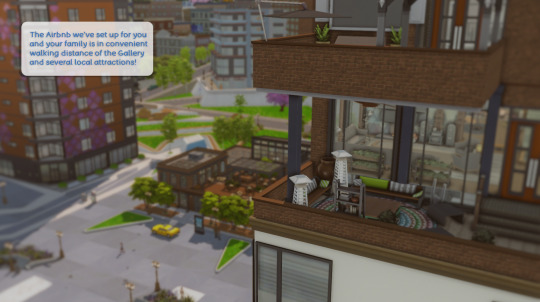


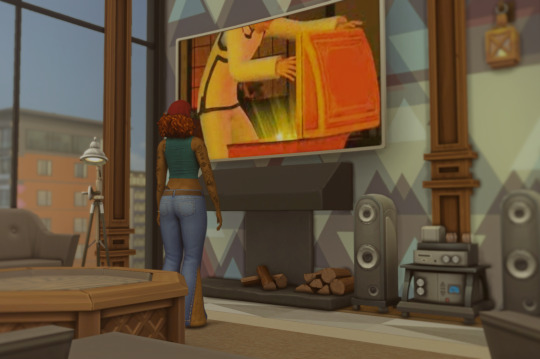


3 days and 2 nights in San Myshuno!
Thank you for accepting out invitation to showcase your work at our Gallery. The Airbnb we've set up for you and your family is in convenient walking distance of the Gallery and several local attractions! We can't wait to see you at the showcase.
-Casbah Gallery
#ts4#ts4 gameplay#sims 4 gameplay#postcard legacy challenge#postcard: gen4#queue#little andrew dealing w the anxiety of being with the family#from having no one to havinf everyone all at once#in game he's going through “the distant” phase which i think works so well narratively#adrien's hair has more greys but i didn't realize i had accidentally changed it 🧍🏽♂️#ama standin front and center of that bug ass screen#BACK UP!!! rua for damn sure didn’t work in a glass factory#the message from the gallery is so lame ngl i didnr have any inspiration for this and just wanted something to put out#i imagine the letter would be much longer#i guess#ANYWAY you know who else is in san my 🫂 ART!!! he’s so handsome y’all
155 notes
·
View notes
Text
Artist’s statement: Ys, or, Borrowed from the Sea
A shortcut to mushrooms
My interest in alternate worlds was piqued when I first read The Hobbit, and the first two volumes of Lord of the Rings, The Fellowship of the Ring. The maps, the histories, the biographical information and allusions to genealogies, the languages and cultures and very real, lived-in countries, the sense of geography in that the story took place as much between points of interest as it did within points of interest, simulating the time it took to travel between cities – all of these factors hooked me as much as the story had. It is from the world of Middle Earth and the history and accidents of its construction that I derived much of my inspiration for this project.
However, as we must with all our favorite creators, I returned to the Lord of the Rings with a more critical eye years later. After coming out as transgender, going through a long health crisis, beginning to critique my own whiteness, and reading a lot more about philosophy and social science theories, I had more tools and lenses through which to critique the premises on which Tolkien wrote the darling of English fantasy literature.
It seemed Middle Earth was a project born out of Tolkien’s devout Catholicism, and the cosmology of Middle Earth heavily reflected Tolkien’s own interpretation of Catholic teachings. There were angels and fallen angels, and a battle between them on the physical world that took it off track from the plans of the all-knowing Eru Ilúvatar (Tolkien‘s analogy for the Father). This would all be well and good in theory, if Tolkien hadn‘t taken a step further and made ”Good“ and ”Evil“ sentient races, created by individual angels with certain aesthetics and moral philosophies in mind that would irrevocably be tied to the bloodline of each of these races. This already has problematic implications for Tolkien‘s racial frame, but to make matters worse, he based certain fantasy races on certain groups of humans on Earth.
So, with these pitfalls in mind, I put my initial worldbuilding efforts not into creating languages and cultures, but rather creating a planet that they could live on, that could feasibly exist in our galaxy. I didn‘t include magic in its formation, I didn‘t use a mythic structure at first. I didn‘t even know if I wanted to populate my world until I had an entire solar system. I knew things like the luminosity, age, and mass of the star, the distance between the star and planet, the length of the year and day, the axial tilt of the habitable planet, how all of that would affect the seasons and climate, and how far away the moon was and what it would look like from sea level on my planet. I knew how deep the oceans were and I even had some speculative biology plotted out for how life would come to be on this planet. My idea was, I wanted to make a hard scifi world (within reason – I‘m not Andy Weir) and then drape a cloak of high fantasy on it, almost a bit more like Dune by Frank Herbert than Lord of the Rings.
My readiness to populate my planet with peoples and histories neatly coincided with the beginning of my Purchase career. I was no geologist, geographer, meteorologist or astronomer. Though I was certainly interested in how ores were distributed in my planet‘s crust, how coastlines and climates developed, and how the sky would appear from the surface from my world, the central focus had always been and would always be how these things would all affect my fictional societies and their growth. What would it be like to grow up on a world where the moon appears so much larger than the sun? A world where the solar year is just a bit over 639 Earth days? Would it be possible, given different historical circumstances, to achieve a Type 1 or 2 Kardashev civilization? How would such a civilization come about politically?
Worldbuilding as anthropological exploration
After learning of my passion for worldbuilding, a professor suggested I take a look at the 2015 presidential address to the AAA by Monica Heller, called ”Dr. Esperanto, or Anthropology as Alternative Worlds.“ In it, Heller outlines the history of perhaps the most famous constructed international auxiliary language, Esperanto, and maps its positionalities, along with those of its creator, L. L. Zamenhof, within the scope of highly anthropological inquiry. Zamenhof was situated at the precipice of many different identities; he was a Jew from Bialystok, a multilingual city which in his lifetime lived under Russian and Polish-Russian rule. His interest in creating an international auxiliary language was one of diplomacy and peacemaking in the years preceding World War I, a time where international tensions and the influences of global industrialization and capitalism were all growing ever stronger and more binding. Esperanto‘s goals have since changed slightly; on a sticker on the back of a Paris street sign in 2013, it was hailed as ”La langue internationale équitable,” marking Esperanto as the “equitable” opponent to the specifically capitalist problem of income inequality. One can only conclude that not only the language itself, but also the act of its creation by Zamenhof, was a highly political project. Heller then touches upon other forms of constructed language, ones whose purposes lie in artistic expression and exploration such as Dothraki and Sindarin. The article taught me that “the act of transportation [to an alternative world] might have unexpected consequences. But the whole endeavor will be transformative, teaching us things we would never have learned otherwise” (Heller 2015: 21).
Since finishing this article, I have embarked on a journey to ground my project in social theory. My goal began as less utopic and more experimental. It was not yet apparent to me how my politics would manifest in the work, but I still wanted to play the game: with a number of minor changes to a habitable world from Earth, and a number of restrictions in how I depict the cultures, can I keep my civilizations alive and, more importantly, ”breathing“ (that is, relatably and realistically complex enough to feel lived-in), until they reach Kardashev Type 2 status? (That is, until they can technologically harness as much energy from their home star for use as they like.) What would stories look like set in this universe, perhaps stories set in the same star system but separated by hundreds or thousands of years? And how do I responsibly depict these people without falling prey to the same ideological traps that Tolkien and Herbert did?
This new phase of my project also coincided with my renewed interest in the works of Ursula K. Le Guin and the Nickelodeon show Avatar: The Last Airbender. A:tLA stood out as a shining example of how to write a complex, colonially-charged political history between societies without directly making any one society analogous to Western Europe or Euro-American whiteness. I devoured Le Guin‘s The Left Hand of Darkness, which taught me that even tiny changes to human cultural frameworks (such as, what if there were no gender as such, and what if everybody on a planet were asexual except for a predictable period of sexual arousal and attraction?) can have vast implications for that society‘s history (Le Guin theorized that on such a planet, there would be no concept of war); and The Author of the Acacia Seeds and Other Extracts from the Journal of the Association of Therolinguistics (Le Guin‘s own term for the supposed study of animal language) which taught me that the lenses of imagination can be focused just as strongly on our nearest neighbors in the dirt as they can be on the distant stars.
I therefore decided to take a hybridized Tolkien / Le Guin – ian approach to writing the stories. I committed to ”translating“ every character‘s pronouns into the English feminine, and only gendering them at all as feminine when necessary. I also committed to writing a world history where no one ethnic group was directly analogous to Euro-American whiteness, à la AtLA. I would of course need to loosely base groups located in geoclimatic zones on similarly-located groups on Earth, or else have altogether too much work to do (deciding how much of the culture‘s development might be affected by the geography and climate; deciding on a model of anthropology on which to base my analysis of each culture, be it structural, evolutionist, structural-functional, etc.; building each cultural good, artifact, and practice in relation to every other; conducting a simulated ethnography of each of my major ethnic groups).
So, I decided to base some of my cultures on recent ethnographies and archaeological studies of geoclimatically analogous Earth ethnicities. The first of these was a master‘s thesis by Meghan Walley, ”Examining precontact Inuit gender complexity and its discursive potential for LGBTQ2S+ and decolonization movements.“ In it, Walley complicates the gendered narratives of pre-contact Inuit history by critically analyzing remains and gender-specific tool usage, and conducting interviews with living queer Inuit and their families. Walley found that Inuit-specific definitions of Two-spirit gender and sexual nonconformity had existed since long before contact with Europeans, and that queer archaeological practices were necessary if the living traditions of extant Two-spirit and queer Inuit were to be given their appropriate ontological priority over colonial narratives. I decided to use this thesis as a springboard for reading more current histories of the Inuit and other people of the far North, to embark on my project of constructing plausible cultures for the people living near my planet‘s South Pole.
The magic of semiotics
Then: a type of breakthough. Last summer I found myself reading book after book, including Tao Te Ching, the foundational text for Taoism, and How Forests Think: Toward an Anthropology Beyond the Human, Eduardo Kohn‘s posthuman ethnography of a Runa group located near Ávila in Ecuador. In it, Kohn tries to apply the semiotic theories of Charles Sanders Peirce to human groups living in rainforest settings to construct and analyze a broader, more current, postcolonial cosmology for this Runa group and its implications for other groups’ cosmologies. It was my first encounter with Peircean semiotics. Oddly, How Forests Think referred in passing to the very chapter of Tao Te Ching that had resonated with me strongest: Chapter 11, in which Laozi talks about constitutive absence, the anti-structures that permeate structure and make structure functional (the examples he gives include the empty hub of a wheel, the space inside a clay pot, and the emptiness enclosed by a room’s four walls). Kohn applies this anti-structure model to the semiotic, saying that Peirce’s types of signs can only signify when they represent things that are not present. A child buzzing their lips to imitate an airplane will only remind you of an airplane if you forget the differences between the child’s imitation and the sound it is meant to represent.
From How Forests Think and Tao Te Ching, I derived six major tenets that I would literally incorporate into my text’s lore as an ancient religion. But more than that, it got me thinking about how language and signification was a type of magic, in many ways. So, I re-incorporated magic into my story. I based the initial rules of my magic system on the postulate that this universe was not ours, in fact, but had grown out of a knowable Universal Field that could be at least partially described with a type of grammar. This Syntaxelium (designated as such both to distance it from concepts like Chomsky’s Universal Grammar and innateness hypothesis, and also to connect it more closely to ideas of networking and fungal semiosis) could be harnessed in languages that contained its features to “negotiate” with the universe. That is, if you speak a language that uses a lot of features of the Syntaxelium in a short amount of time, you are “persuading” the universe to change some of its rules, at least for enough time to grant you a wish. I decided to make this language too complex to be conservative; that is, it would evolve and diverge very quickly from any one set of rules as people used it and streamlined it. There was a constructed language I knew of that might serve perfectly: the language Ithkuil, completed by John Quijada in 2011 and so complex that nobody, not even Quijada himself, is yet fluent in it as of this writing.
Ithkuil is a philosophical-engineered language whose design goals are to be as semantically condensed and specific as possible. There is a single “formant,” or word, in Ithkuil that can be translated as “...being hard to believe, after allegedly trying to go back to repeatedly inspiring fear using rag-tag groups of suspicious-looking clowns, despite resistance” (the word itself is /qhûl-lyai’svukšei’arpîptó’ks). Quijada has offered that Ithkuil is too complex to be a natural spoken language – rather, that it is a useful tool to think about how quickly and reliably information can be condensed into linguistic frameworks. Its philosophy of meaning is (as the author himself admits) relatively Enlightenment-based – that is, there is a one-to-one correspondence of conceptual representation to some Platonic prototype of what an Ithkuil formant might mean, which is not exactly in line with the language’s design goals – but Quijada here threw up his hands: “A more careful and rigourous construction for Ithkuil’s lexico-semantics, given the author’s stated design goals…would not assume such a theory of meaning, but would rather incorporate more recent findings of cognitive science and cognitive linguistics to reflect embodied meaning and metaphor-based conceptualization. However, pursuing such a foundation for the lexico-semantics of the language would, in the author’s opinion, be extremely time-consuming (on the order of many additional years, perhaps decades, to construct)” (2011: 270-271).
I found this thoughtfully constructed masterpiece of a language perfect for my purposes and set about creating daughter languages that may have evolved from its natural use in my world. I imagined that a group of priests of the Moon Queen had created Ithkuil in-world as an attempt to access the power of the Syntaxelium and communicate with the Goddesses. These priests partially succeeded, in that their new language granted them magical powers. They did not become all-powerful, however. These new Wizard-Queens attempted to conquer the world with their magic, and largely succeeded – but once they had spread out, Ithkuil almost immediately diverged into daughter languages due to its complexity, each of these languages preserving different features of the Syntaxelium. After a few generations, the language with the most expansionist, imperial-minded speakers would conquer the world once again and spread their language into every corner of the globe. The language would diverge again, and the cycle of colonization and genocide would continue until a group of marginalized people led a revolution against their contemporary empire and broke the chain.
The politics of translation
But, at this point I was too invested in this project to continue in my experimental, non-utopic design philosophy. I needed to introduce my polemic into the work, or else it might carry messages contrary to my values (it may regardless, but at least I can try and make my intent as clear as possible). I needed my writing to reflect a strong opposition to, or at least complication of, Enlightenment ideals. I would also paint a picture of the post-revolutionary society I dreamed for my characters, which meant I needed to refine my anarchist sensibilities with a deep dive into ethics and anarchist theory.
I decided to illustrate the conflicts between more Enlightenment, classical logic-based arguments and more post-Enlightenment, posthuman arguments in a contest between two translators trying to render the same text into English. I therefore refined the six tenets of my constructed religion, translated them into Ithkuil, then rendered them back into English in two competing and slightly different ways:
1. tʼal-lrëikțatf orêtfiáss arkʼarț
[tʼal.lɾəɪkθatf ɔˌɾeːtfɪ.ˈas.s ˌaɾkʼˈaɾθ]
similarity.p1s3.IFL-MLT.N-MNF-HAB-EPI thought.p2s1.FML-MLT.N-v2ss/9-GEN source.p1s1.FML-AGG.N
“It is known: some reminder is the source of any thought.” – Eloquences
“So it is that all thought’s source is a likeness.” – Violet
2. okleomdh âkláʼdh tʼal-lriočʰaț atvufq oráʼtf
[ɔklɛ.ɔmð ˌakˈlăð tʼal.lɾɪ.ɔt͡ʃʰaθ atvʊfq ˌɔˈɾătf]
river.p2s1.IFL-COH.N.PRX-ASI river.p3s1.FML-N.PRX-MED organize.p3s3.IFL-DYN-HAB-EPI.N self.p1s1.IFL-MLT.A-IND thought.p2s1.FML-MLT.N-MED
“It is known: as a current from the channel, so selfhood organizes itself out of any thought.” – Eloquences
“So it is that as the whirlpool from the stream, selfhood knits itself from strands of thought.” – Violet
3. ôcneoț îcnêț atvațoaxiarň tʼal-lrëigadhoaqʼ
[ot͡snɛɔθ iːt͡sneːθ atvaθɔ.axɪ.aɾŋ tʼal.lɾəɪgaðɔ.aqʼ]
spore.p3s3.IFL-N-ASI fungus.p2s3.IFL-N-GEN self.p1s1-IFL-N-v2x/2-v2rň/9 component.p1s3.IFL.MNF-HAB-EPI-N-v2q’/2
“It is known: as the fruiting body of the fungus, the crucial, tiny self is the visible component.” – Eloquences
“So it is: the smallest self is the most crucial visible component, as the spore of the fungus.” – Violet
4. tʼal-lreijjaçoak ekraxiuk amvouț tʼal-lrükrațíukiss
[tʼal-lɾɛ.ɪʒ.ʒaçɔ.ak ɛkɾaxɪ.ʊk amvɔ.ʊθ tʼal.ˌlɾuːkraˈθɪ.ʊkɪs.s]
motion-in-situ.p1s3.IFL-v2k/2-ASO.N.PRX-DYN.EPI.HAB tool.p1s2.IFL-ASO.N-v2k/1 center.p11.IFL-N.NAV tool.p1s2.IFL-N-v2k/1-v2ss/1-MNF.HAB.EPI-framed
“It is known: a good wheel spins right about the hub, where there is no wheel.” – Eloquences
“So all wheels spin ever toward their wheel-less centers.” – Violet
5. öpatf uizát tʼal-lripšasúemzeoj ékëuʼady tʼal-lreisásiull
[øpatf ʊ.ˌɪˈzaθ tʼal.ˌlɾɪpʃaˈsʊ.ɛmzɛ.ɔʒ ˈɛkəʊ̆ʔadʲ tʼal.ˌlɾɛ.ɪˈsasɪ.ʊl.l]
carrier.p22.IFL-MLT.N mind.p1s1.FML-N-MNF happen.p1s1.FML.DYN.HAB.EPI-PRX-framed-v3mz/9-v2j/6 path.p1s2.FML-A.PRX.PRV-ABL-framed deviate.p1s3.IFL-DYN.HAB.EPI-framed-v2ll/1
“It is known: a ‘thing’ is a self which acts automatically as expected, and never deviates from its predetermined path.” – Eloquences
“So inanimate is the self which obeys only habit, and never strays from destiny.” – Violet
6. tʼal-lriokápps oratfiáss âkțîʼatf
[tʼal.ˌlɾɪ.ɔˈkap.ps ɔɾatfɪ.ˈas.s ɑkθiːʔatf]
path-oriented translative motion.p3s3.FML-A.TRM-DYN.HAB.EPI thought.p2s1.FML-N.MLT-v2ss/9 similarity.p1s3.IFL-ALL-MLT.N
“It is known: finishes, arrives, any and all thought at a type of reminder.” – Eloquences
“So the destination of a thought is a likeness.” – Violet
As I mentioned, these six tenets were adapted from the Tao Te Ching as interpreted through Charles Sanders Peirce’s semiotic philosophy. They have to do with the origins and ecologies of the self, the necessity and inevitability of communication, and the structure of thought. Why did I create two different translations of the same text in-world? I wanted to show how political of a project translation can be. For example, the less rigorous Violet Text translates the epistemic-habitual modal affixes of the main verbs as “so it is,” whereas Eloquences uses “it is known;” I did this because though they might not seem such different phrases, “so it is” distances the knowledge from a knower – it poses the knowledge as an immutable state of reality, rather than an interpretation derived by an observer. As I learned from readings of Victor Turner, Antonin Artaud and Roland Barthes, such mythologizations are processes of naturalizing the events of a narrative until they lose their historicity, and seem to follow simply from common sense. Mythology transmutes history into a string of isolated, politically vacuous events that could never have happened any other way.
Further examples of the differences between these hermeneutic exercises are in the translation of “similarity.p1s3” in Tenets 1 and 6. Eloquences renders this as “reminder;” the Violet Text, as “likeness.” Why is “reminder” any more nuanced? Why might “likeness” lead the reader astray? To me, “likeness” implies literal similarity; a sort of facsimile relationship between an “original” and “copy.” I took these tenets from Kohn and Peirce directly: Kohn says that all thought begins and ends with an “icon.” “…[A]ll semiosis ultimately relies on the transformation of more complex signs into icons” (Peirce CP 2.278 cited in Kohn 2013: 51). By an icon, Kohn and Peirce mean a type of sign that stands in representationally for another in a very literal sense, like an onomatopoeic sound-image or a drawing of a smiley face. These icons aren’t supposed to be technical, detailed imitations, but rather empty stand-ins to quickly communicate a desired connotation. Therefore, a “reminder” suffices as a translation of “similarity.p1s3,” because the relationship between the sign and the referent is not always one of literal similarity.
The limitations of magic
Or, other magics that do just as much
If we take from Mauss that magic is highly grammatical, that it follows closely to linguistic processes, then my equally linguistic magic system’s limitations must lie in the exclusive capabilities of non-linguistic systems, or perhaps even non-semiotic systems. We must turn to the affect theorists. Is the magical self truly nothing more than a set of interpretants, signaling to each other through eternity? What would the implications of this be for free will and the power of the individual vs. the community? This takes me to my current readings of Deleuze & Guattari’s A Thousand Plateaus: Capitalism & Schizophrenia, translated by Brian Massumi, and Massumi’s own Movement, Affect, Sensation: Parables for the Virtual. These books challenge the idea that the self can be reduced to its linguistic processes, and posit that the “emptiness” at the hub of Laozi’s wheel, the constitutive absence at the heart of these semiotics, can actually be filled with direction, with velocity – a sort of perpetual growth into excess meaning that’s difficult to pin down in definition or interpretation.
Massumi takes from Bergson that any space, including the political geography upon which poststructuralism maps identities in their “positionalities,” is formed retrospectively from the completion or frustration of dynamic, unmediated processes of movement and sensation in the body. For Massumi, there is an incorporeal element of The Body – its movement through spacetime – that is ontologically privileged before the formation of The Discursive Subject. “Another way of putting it is that positionality is an emergent quality of movement,” says Massumi (2002: 8).
Emergence is another effect that I address in my Tenets; Tenet 2 deals with selfhood as an emergent property of interacting thoughts, as per Kohn and Peirce. Peirce’s semiotic often grapples with the problem of continuity vs. description, creating almost a Heisenberg paradox of its own wherein a thought can only be described precisely as a positional snapshot, or as a “nondecomposable…dynamic unity” (Massumi 2002: 6). Peirce formulated his three types of signs as emergent properties of each other; indices are emergent properties of the relationships between icons, and symbols are emergent from analogous interactions between indices, or indices and icons. So selfhood, language, and magic all organize themselves from the simplest signs, which is why Peirce and Kohn say all thought begins and ends with an icon. It seems there are parallels within these genealogies of thought, between the Deleuzian affect theorist Massumi and the semiotic of Peirce as it applies to posthumanism. Can the analogy be drawn further to say that if space is an emergent property of movement as selfhood is of thought, then movement and affect is its own kind of non-semiotic magic that must have an effect on spacetime?
#musings#me#assignments#school assignment#anthropology#affect theory#deleuez#deleuze and guattari#guattari#massumi#semiotics#charles s peirce#charles peirce#peircean semiotics#mauss#magic#magic systems#worldbuilding#ithkuil#translation#conlang#conlangs#tao te ching#victor turner#antistructure#anti-structure#ursula k. le guin#uk le guin#le guin#esperanto
3 notes
·
View notes
Text
Level Design Workshop: Blockmesh and Lighting Tips
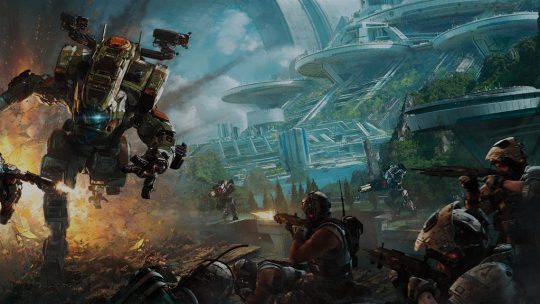
I watched this talk from David Shaver about level design with blockmesh.
The talk is packed full of amazing tips for any aspiring level designer.
Level Requirements
Environment Type
Time of Day
Location in Story
Available Character Abilities
Enemy Types
You should think of these before starting the level design as these will influence how you design your level
Affordance
A way to communicate to the player what to play with or where to go
Players learn the affordance rules via consistent color and shape and a trust contact is formed.
Ensure affordances work consistently game-wide.
Add to your blockmesh for playtests
Affordance is a way to tell the player where they should go or what they can interact with. For example when we look at a door we can tell its push or pull just by seeing the handle.
You can use colour and shapes to tell the player where to go. For example Mirror's Edge uses the colour red. Or you can use shapes, such a piece of wood partially hanging off a building to indicate you can jump off it.
You can also use both, such as having an edge on a cliff that sticks out and is a different colour.

Denying Affordance
A way to communicate to the player where they can’t go
This is using the same techniques from before but you are achieving the opposite result
If you did not want a player to climb up a wall, you could push foliage on top or have spikes on top. This will let the player know they can’t go there
You can use this together with affordance, an example being having a door boarded up but the window open, indicating to the player they need to enter the house through the window.

Visual Language - Shapes
Shape Consistency is important - communicates affordance
Primitive shapes have an effect on player psychology
We can use this to guide players.
Certain shapes have an effect on player psychology.
Round Shapes are considered safe and not dangerous
Rectangular shapes are considered stable, like a safe house.
Diagonal Shapes are viewed as dangerous
You can use Round shapes to indicate safe area the player can walk, while using diagonal shapes to nudge the player on the right path.
And finally having a square building will give the player a goal to arrive at where they know they will be safe.

Visual Language - Colour
You need this to be consistent with the environment. For example, if you use a bright green in a mossy cave to indicate where you can climb it would feel right and consistent. However if you used bright green to climb a rock in the middle of a desert it would not be consistent with the environment.
Colour consistency is important - it communicates affordance
Colour provides context in a blockmesh
Gets the team on the same page without explanation
You can contrasting colours to guide the player, such as having the top of edges you can climb be a colour that stands out.
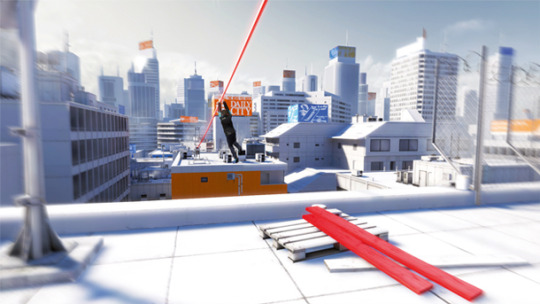
Landmarks
Orients players.
Distant object seen from many vantage points in the level.
A goal to work towards.
Using landmarks creates a goal and can guide the player. It also lets them know they are going the right way.
When building the level, a good way is to create the landmark and build backwards from it.
This lets you shape the level around it.
Half Life 2 does this well with its Citadel, acting as something the player was going towards at the start, then away from the Citadel and eventually back to it.

Openings Attract
Caves, doors, arch ways, etc.
Often leads to a refuge space, which psychologically feels safe
Mystery -”What could be Inside?”
Having an opening in a wall encourages the player to enter.
If you have an opening, try and make it stand out so the player can see it.
Using opening can encourage players to explore different paths in your level.
An example I can think of was when I first played Mario Kart 64, on the Koopa Troopa Beach level. I remember when I first saw the hole in the mountain and was wondering what was in it, and I stopped racing and my new goal was to try and get into the cave, just to see what was inside.
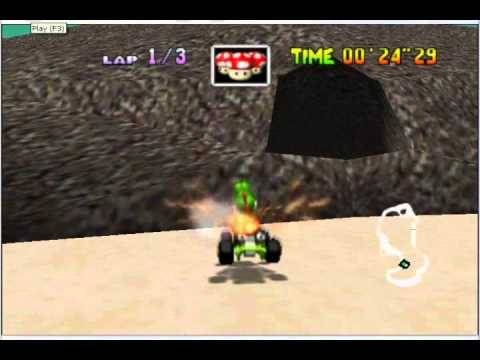
Gates and Valves
Gates stop progress until conditions are met
Valves prevent backtracking.
Both reduce the possibility space and prevent aimless wandering.
Great for linear games, but can be sprinkled into open worlds too.
Gates are pretty straight forward. The player has to achieve something before they can progress, such as killing all the enemies or solving a puzzle.
Valves however stop the player from backtracking. You can do this with a door closing behind the player, or the player jumping down from a ledge they can’t climb back up.
Gears of War would do this a lot, and do it quite well. You would go into a room where you have to push forward and fight enemies who have a strategic position. You would then fight more enemies once you are in the strategic position.
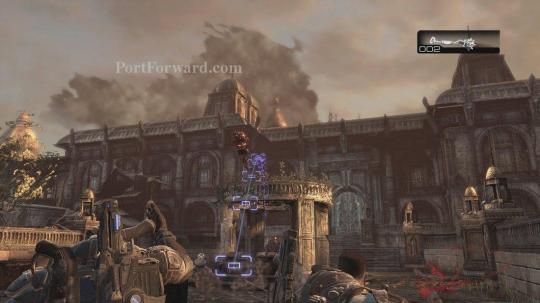
Leading Lines
Lines that draw your eyes to the intended point of interest
Composition technique
Roads, pipes, cables, etc.
Leading the players eyes if one of the most important things with level design. If you need them to find a certain object or see a certain event, using leading lines can help you lead the players eyes.
For example, this photo of Titanfall 2 uses pipes to lead the players eyes towards a door. An enemy will barge through the door and without these pipes the player might miss the moment that happens.

You can also use leading lines to guide the player where you want them too. In the photo below, you can see the pipes on the right encouraging the player to follow them.

Pinching
Angle shapes to funnel players to a specific spot.
Good for redirection
Great for setting up a reveal.
Depends on your mobility mechanics.
Pinches are useful forcing a player to look in a certain direction. You can use these when you want the player to see something important.
In the example below, by forcing the player to go walk through this pinch, they will clearly see the hospital in the distance and know they are going the right way.

Framing and Composition
Draws attention to point of interest by blocking other parts of the image, making it stand out.
Google photography composition techniques - lots of good websites
Great when combined with Pinching.
You can use the layout of the level to frame important objects. In the photo below you can see that river helps lead the players eye towards the dam, which helps frame the building.
In the Last of Us 2 trailer, there is a moment where the car is facing to the right which draws the players eyes there, and then there are two perfectly framed trees with light shining from them. This clearly shows the player the way to go even though the player is in a forest.

Breadcrumbs
Attract/lead the player, a piece at a time to a goal
Can be almost anything that draws the eye
-Stuff that breaks up the negative space of floor/walls.
-Pickups
-Enemies
-Lit Areas
Usually better to add after early playtests of blockmesh to see if they are even needed.
Breadcrumbs help lead the player. You essentially litter the ground with a trail of objects.
A classic example is Super Mario games, where they use coins to lead the player.
I really like this technique as its super simple but highly effective.
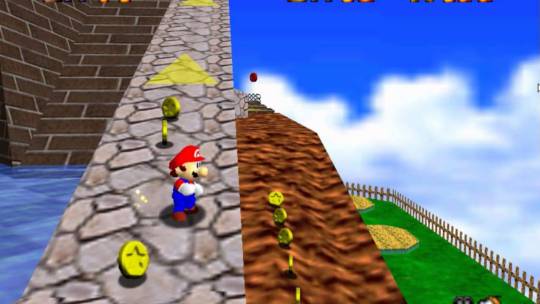
Textures
Just point the way to go
Examples
-Arrows pointing the way
-Scrapes on the ground/walls
-Signs
-Etc.
You can use textures to act as an arrows to tell the player where to go.
In my narrative game I have used blood smears and drag markings on the ground to guide the player.
In some games you can even just use an arrow if it matches the environment, such as in a street with a sign that tells you where the area is you have to go.
You should try and block these out in your blockmesh.
Movement
Use movement to grab the eye.
Examples:
-Big Scripted moments
-Birds
-Spark FX
-Enemies
-Something flapping in the breeze
Guides the eye to where you want the player to go
I like the idea of using movement to grab the players attention. It helps them to notice things you want them to see.
Doing this in the blockmesh phase is highly dependant on your game
Try to do it anyway for your playtests
Cubes triggered to lerp in a direction or along a spline will suffice
Can be a late game bandage for guidance
Light and God Rays
Players are attracted to the light
God rays draw attention and a line to the goal
Important in blockmesh phase.
I believe lighting is one of the most important things to think about when designing a level. It helps guide the player, show them points of interest and can hide areas you don’t want them to go too.
God Rays in particular act as a beacon.
What I really liked was how he mentioned a squint test.
The Squint Test is where you squint your eyes and have a look at your game. What stands out when everything is blurry?
Whatever stands out is the first thing people will see when they play your game.
This entire talk is amazing and is so jam packed full of information.
This talk taught me of so many things I should be thinking about in the blockmesh stage of level design and how to think of ways to guide the player throughout your levels.
As an aspiring level designer, this video is the best video to teach you about everything you need to know.
2 notes
·
View notes